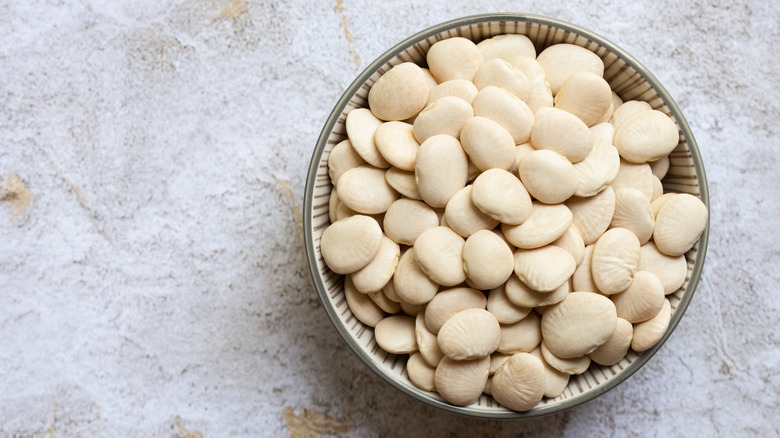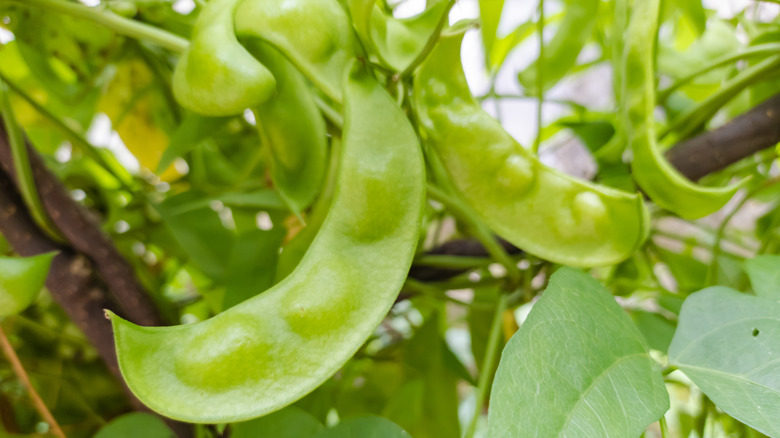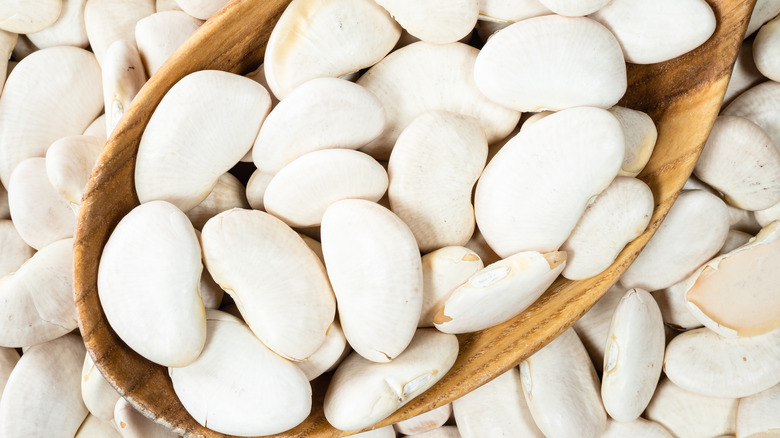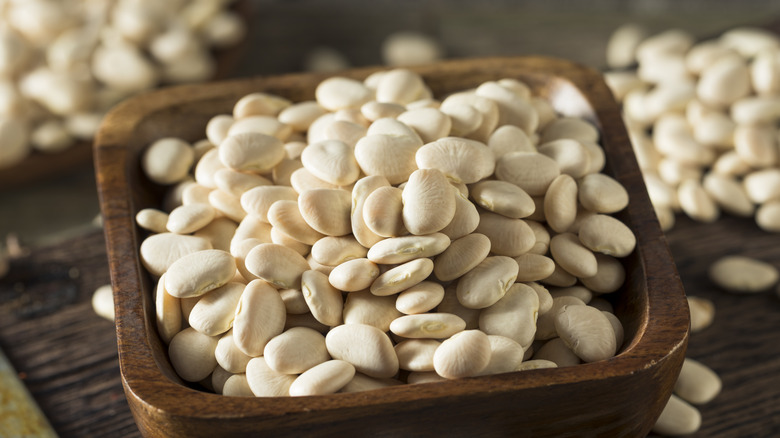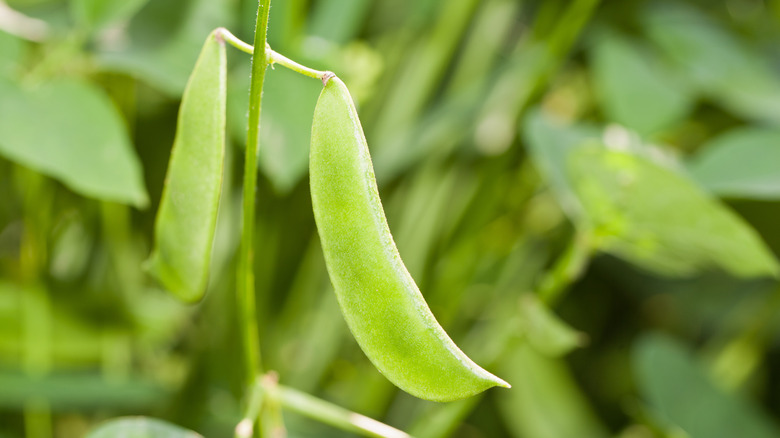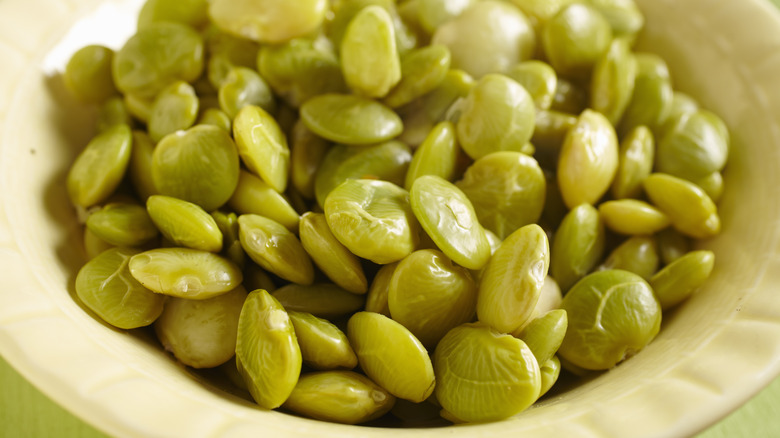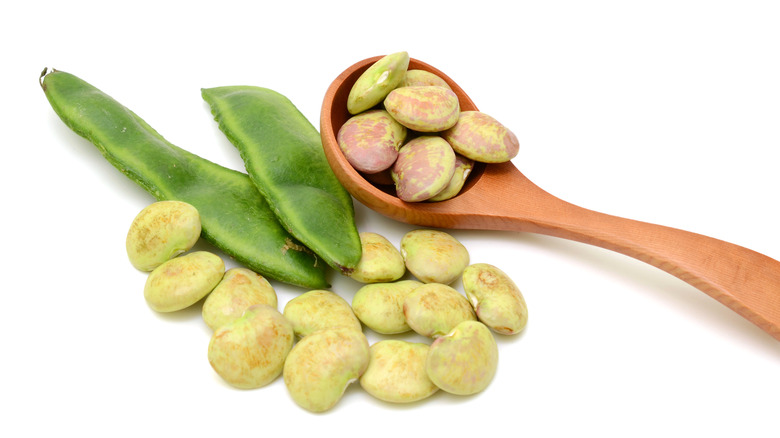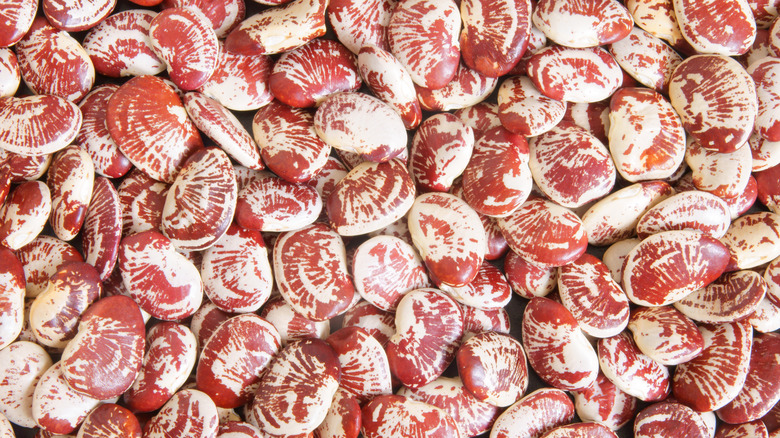What Are Lima Beans And Are They Nutritious?
Beans often work as a humble hero in the cook's pantry, bulking up stews and casseroles while letting other, bolder flavors shine. Still, some beans deserve a more grand place in your dinner plans, as they can pack enough taste, texture, and nutrition on their own. One such bean? The lovely lima bean.
Beloved by cooks of the South and an ancient crop from South America, lima beans are thick and creamy beans worthy of special attention. Its name offers a nod to the bean's Peruvian origin, though it's pronounced lie-ma rather than lee-ma (the proper way to pronounce the capital of Peru).
Why has the lima bean endured as a staple pantry item since the time of the Incans? It's a powerhouse ingredient packed with vitamins, minerals, and proteins, as well as a filling dose of fiber. Let's take a look at the history of the lima bean and the many ways you can buy, prep, and cook them.
The Peruvian history of lima beans
The lima bean has a geographically complex history. Though its scientific classification name is phaseolus lunatus, with the second part referring to its half-moon shape, the lima bean received its most popular title from its point of origin: Lima, Peru. The lima bean has been a cultivated crop of the indigenous Peruvians for nearly 9,000 years, once feeding the ancient Incan empire along with quinoa and potatoes.
In fact, the legume is so significant to the Peruvian diet that visuals of the plant can be found on 15th-century pottery of the Moche, a tribe that occupied northern Peru. Farther north, Native Americans located in the south also relied on lima beans as an important food source.
Once European traders came in contact with the New World and the lima bean, they soon shared it with the greater world, adopting the bean as a primary crop in the Philippines, South East Asia, and Africa. Finally, in the southern states of North America, lima beans have been embraced by the soul food and comfort food tradition and come either in a full-grown, mature state or smaller and more tender.
The many names for lima beans
Etymologically speaking, lima beans have a complicated number of names. Most of it is determined by what area you find your lima bean. In most areas of the U.S., the lima bean is the name of choice, but specifically in the South, lima beans will be delineated by the name butter bean. Farther afield, places like the United Kingdom also call them butter beans, while most of Europe calls them Madagascar beans, as the majority of lima beans sold in Europe are grown on the African island.
Meanwhile, in places like Thailand or Malaysia, they are often known as Rangoon beans or Burma beans. They can also be summed up as Gigante beans due to their large size and, in various places, as wax beans, chad beans, and even sieva beans. Despite all the disparate names across the globe, these beans are all identical, and you can assume you'll be working with the same tastes and textures.
How the lima bean tastes
Flavor-wise, the large lima bean has a mildly nutty and sweet taste and a texture that can either be described as velvety or chalky, dependent on how you feel about its starchy richness. The less mature version of the lima bean is likened to the fava bean in terms of its mealy texture but otherwise tastes the same.
Many cooks love lima beans because of this combination of mild flavor and starchiness, as it makes them the perfectly absorbent base for stews, sauces, and braises. Meanwhile, the mild sweetness of lima beans makes it a good pairing with deeply savory cuts of pork, like salty fatback or smoky bacon.
The taste of lima beans can, however, be changed by poor cooking. Cooked too long, lima beans will taste almost sulfur-like, but cooked too little, their texture will be as dry as brittle chalk. But this is not reflective of the delicate flavor and tender texture when cooked properly.
The nutritious side of lima beans
First and foremost, lima beans are chock-full of fiber. This helps in two ways, keeping eaters satiated for longer and aiding in digestion. Beyond offering a filling dish, lima beans are bursting with good vitamins and nutrients. A single serving of lima beans packs a wallop of potassium and vitamins C and B6.
It also has plenty of vitamin K1, a vitamin crucial to the growth and repair of tissues. Add to that a boost of micronutrients like manganese, copper, and magnesium, and you're looking at a legume superfood. For those suffering from anemia, lima beans provide a crucial amount of iron, helping them combat fatigue and weakness.
On the flip side, raw lima beans contain linamarin, a cyanide-like compound that can be toxic to humans (via Healthline). Luckily, as long as the beans are cooked and processed properly, they are safe to eat. Just don't risk trying to eat raw lima beans.
How to cook with lima beans
Whether working with dried, canned, frozen, or fresh lima beans, there are numerous ways to prepare them. Canned and frozen butter beans require the least amount of prep, as they've already been cooked and need only reheating, but dried lima beans are also an option. You'd prep them like any other bean, soaking them overnight before boiling them in a large pot of water until tender.
Fresh lima beans are only to be found in high summer at farmer's markets, but they're a real treat if you can locate them as they'll have a fresher and greener taste than others. You can boil them in a pot of salted water and have them on the table in less than 30 minutes.
Beyond those simple ways to cook them, there are plenty of flavorful recipes to try out as well. Perhaps one of the most traditional recipes you can make with lima beans is succotash, a bean, corn, and squash side dish which uses the three crops Native Americans swore by, the famed Three Sisters. You can also use lima beans in Kentucky burgoo, a meaty stew that uses the bean as its starchy heart and is often served on Derby Day.
If you're looking for a more exotic use for the legume, you can try a Spanish-style butter bean dish, where tomatoes and smoked paprika play a starring role. Or, keep it simple and stew your butter beans with salt pork, water, and a bit of seasoning.
Where to buy lima beans
The easiest way to get your hands on lima beans is to head to the canned and dried bean section of your grocery store. Chances are, you'll find a generic version of large lima beans in both dried and canned versions. Frozen lima beans can be a little more hit or miss, but places like Walmart have been known to stock them. However, if you're looking for lima beans in a specific state of growth, like the juvenile butter beans, try shopping via Camellia Brand, where dried large and baby white lima beans are sold well as dried green baby lima beans.
As for the grand poobah of them all, fresh lima beans, you'll probably only find them at one time of the year and in one specific place: the dog days of summer at the roadside farm stand or farmer's market. Fresh lima beans need to be quickly sold after harvesting, hence its time constraint and rural setup. You may get them still in their pods, but some fresh lima beans are sold completely shelled. However, if you do get your hands on some fresh lima beans, you can blanch them and freeze them so that you can use them at a later date while still preserving their freshness. So if you see them, break for them — the lima bean is well worth the effort.
Different varieties of lima beans
The most common lima beans you'll come across at the grocery store are white, pale green, or light tan colored, but that isn't the only color of lima bean out there. There are numerous varietals of lima beans that come in a painter's palate of hues, from white-speckled maroon to aubergine-striped buff. While taste and flavor will generally stay the same, it's worth knowing several popular ones and their culinary specialties.
Fordhook lima beans are the favorites of mass producers and the ones you are most likely to find at the store. Why so popular? These butter beans are resistant to disease and can grow well in most conditions, making them a flexible choice. If size matters, try Big Mama lima beans, a plant that yields jumbo lima beans perfect for a rich cassoulet.
But if you're looking for lima beans that sport surprising colors, look for the two varietals: the Christmas lima bean and the Jackson Wonder. Though it can't be grown during the Yuletide season, the Christmas lima bean has a lovely red and white exterior that contrasts delightfully with its bright green pod. Developed to grow in particularly hot and arid conditions, the Jackson Wonder offers a gorgeous white and purple exterior, adding some colorful contrast to a three-bean salad or 15-bean stew.
